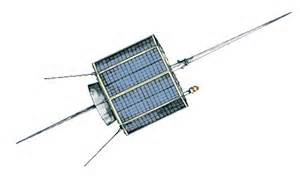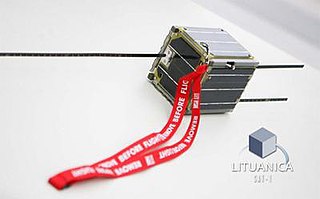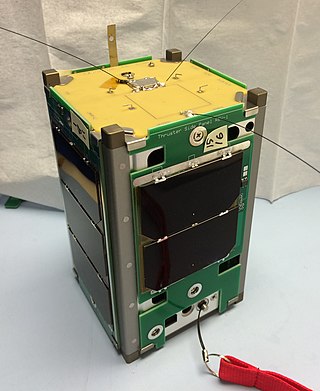Related Research Articles
AMSAT is a name for various amateur radio satellite organizations worldwide. In particular, it often refers to the Radio Amateur Satellite Corporation, headquartered in Washington, D.C. AMSAT organizations design, build, arrange launches for, and then operate (command) satellites carrying amateur radio payloads, including the OSCAR series of satellites. Other informally affiliated national organizations exist, such as AMSAT Germany (AMSAT-DL) and AMSAT Japan (JAMSAT).
The 2-meter amateur radio band is a portion of the VHF radio spectrum that comprises frequencies stretching from 144 MHz to 148 MHz in International Telecommunication Union region (ITU) Regions 2 and 3 and from 144 MHz to 146 MHz in ITU Region 1 . The license privileges of amateur radio operators include the use of frequencies within this band for telecommunication, usually conducted locally with a line-of-sight range of about 100 miles (160 km).

AMSAT-OSCAR 51 or AO-51 is the in-orbit name designation of a now defunct LEO amateur radio satellite of the OSCAR series; formerly known as ECHO, built by AMSAT. It was launched on June 29, 2004 from Baikonur Cosmodrome, Kazakhstan on a Dnepr launch vehicle. It is in Sun synchronous low Earth orbit.
HAMSAT, also known as HAMSAT INDIA, VU2SAT and VO-52, is a microsatellite weighing 42.5 kilograms (93.7 lb), providing amateur radio satellite communications services for Indian and international amateur radio operators. This satellite carries the in-orbit designation of VO-52, and is an OSCAR series satellite.
The 10-meter band is a portion of the shortwave radio spectrum internationally allocated to amateur radio and amateur satellite use on a primary basis. The band consists of frequencies stretching from 28.000 to 29.700 MHz.
Amateur radio frequency allocation is done by national telecommunication authorities. Globally, the International Telecommunication Union (ITU) oversees how much radio spectrum is set aside for amateur radio transmissions. Individual amateur stations are free to use any frequency within authorized frequency ranges; authorized bands may vary by the class of the station license.

AMSAT-OSCAR 7, or AO-7, is the second Phase 2 amateur radio satellite constructed by the Radio Amateur Satellite Corporation (AMSAT). It was launched into Low Earth Orbit on November 15, 1974 and remained operational until a battery failure in 1981. After 21 years of apparent silence, the satellite was heard again on June 21, 2002 – 27 years after launch. At that time the public learned that the satellite had remained intermittently functional and was used surreptitiously for communication by the anticommunist opposition Fighting Solidarity during martial law in Poland.
AMSAT-OSCAR 16, also known as AO-16 and PACSAT, is the in-orbit name designation of an amateur radio satellite of the OSCAR series. It was built by AMSAT and was launched on 22 January 1990 from Kourou, French Guiana on an Ariane 4 launch vehicle. It is in Sun synchronous low Earth orbit.
An amateur radio satellite is an artificial satellite built and used by amateur radio operators. It forms part of the Amateur-satellite service. These satellites use amateur radio frequency allocations to facilitate communication between amateur radio stations.

OSCAR IV was the fourth amateur radio satellite launched by Project OSCAR and the first targeted for Geostationary orbit on 12 December 1965. The satellite was launched piggyback with three United States Air Force satellites on a Titan IIIC launch vehicle. Due to a booster failure, OSCAR 4 was placed in an unplanned and largely unusable Geostationary transfer orbit.
TurkSat-3USat is a Turkish communications nanosatellite developed by the Space Systems Design and Test Laboratory and Radio Frequency Electronics Laboratory of Istanbul Technical University (ITU) in collaboration with the Türksat company along with Turkish Amateur Satellite Technology Organization (TAMSAT). It was launched on 26 April 2013.

LituanicaSAT-1 was one of the first two Lithuanian satellites. It was launched along with the second Cygnus spacecraft and 28 Flock-1 CubeSats aboard an Antares 120 carrier rocket flying from Pad 0B at the Mid-Atlantic Regional Spaceport on Wallops Island to the International Space Station. The launch was scheduled to occur in December 2013, but later was rescheduled to 9 January 2014 and occurred then. The satellite was broadcasting greetings of Lithuanian president, Mrs. Dalia Grybauskaitė. The satellite was deployed from the International Space Station via the NanoRacks CubeSat Deployer on 28 February 2014. All LituanicaSAT-1 subsystems have been turned on, tested and proved to be working properly. The mission is considered a complete success by its team of engineers. The mission ended upon the reentry and disintegration of the satellite on 28 July 2014.
iCube-1 was a miniaturised satellite built by the Institute of Space Technology in Pakistan. Its objective was to conduct a wide range of experiments in imaging, microgravity, biology, nanotechnology, space dynamics, chemistry, space physics and other fields. It also served as a testbed for developing satellite constellations for specific applications.

FUNcube-1 is a complete educational single unit CubeSat satellite with the goal of enthusing and educating young people about radio, space, physics and electronics. It is part of a program which aims to launch more of these educational CubeSats. It is the first satellite with outreach as its primary mission.

Es'hail 2 is a Qatari satellite, launched aboard a SpaceX Falcon 9 rocket on November 15, 2018. Es'hail 2 was built by Japan's Mitsubishi Electric company, and operates at 26° East longitude along a geostationary orbit to provide direct-to-home television services in the Middle East and North Africa region. The satellite features 24 Ku-band and 11 Ka-band transponders to provide direct broadcasting services for television, government and commercial content distribution. In addition to commercial services, the payload of Es'hail 2 includes a linear transponder with a bandwidth of 500 kHz and 8 MHz for the amateur radio satellite service, with uplink on 2.4 GHz and downlink on 10.45 GHz.
Fox-1D, AO-92 or AMSAT OSCAR 92 was an American amateur radio satellite. Fox-1D was a 1U CubeSat developed and built by AMSAT-NA. Fox-1D carried a single-channel transponder for mode U/V in FM. Fox-1D had an L-band converter, which allowed the FM transponder to be switched on an uplink in the 23 centimetres (9.1 in) band.
ParkinsonSAT, PSat or Naval Academy OSCAR 84 is a U.S. technology demonstration satellite and an amateur radio satellite for Packet Radio. It was built at the U.S. Naval Academy and was planned as a double satellite. The name ParkinsonSAT was chosen in honor of Bradford Parkinson, the father of the GPS system. After successful launch, the satellite was assigned the OSCAR number 84.

BRICSat-2, or USNAP1, was an experimental amateur radio satellite from the United States Naval Academy that was developed in collaboration with George Washington University. BRICSat-2 was the successor to BRICSat-P. AMSAT North America's OSCAR number administrator assigned number 103 to this satellite; in the amateur radio community it was therefore called Navy-OSCAR 103, short NO-103.
PSAT-2 is an experimental amateur radio satellite from the U.S. Naval Academy, which was developed in collaboration with the Technical University of Brno in Brno, Czech Republic. AMSAT North America's OSCAR number administrator assigned number 104 to this satellite; in the amateur radio community it is therefore also called Navy-OSCAR 104, short NO-104.
Weber-OSCAR 18 is an American amateur radio satellite.
